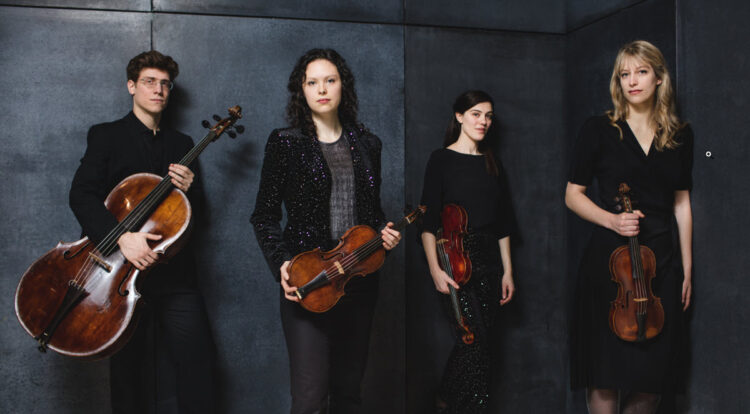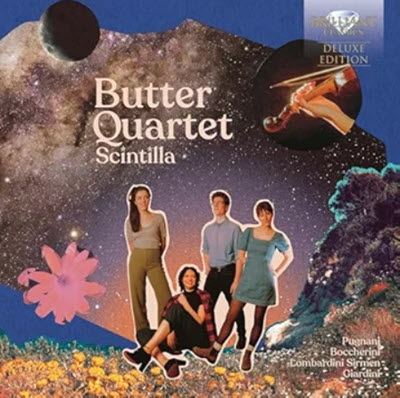by Ken Meltzer
Published November 18, 2024
Butter Quartet, Scintilla: Early Italian String Quartets Brilliant Classics 97407

A gut-string ensemble, the Butter Quartet — violinists Anna Jane Lester and Chloe Prendergast, violist Isabel Franenberg, and cellist Evan Buttar — met while studying at the Royal Conservatory of the Hague and formed in 2017. In a charming play on the group’s name, they “spread the love” of historically informed performances of late 18th and early 19th century repertoire, as well as “newly composed works for historically setup instruments.”

In the liner notes for the Butter Quartet’s debut recording, Scintilla, the artists acknowledge that the beloved string quartets of Franz Josef Haydn inspired an exploration that led them to lesser-known repertoire including works by Italian composers (all, with the exception of Boccherini, virtuoso violinists) written both before and during Haydn’s era.
While the works on Scintilla belong to the genre of Italian galant music, they “are as varied as the unique personalities and ever-changing trends of the 18th century.”
The String Quartet No. 2 in E-flat Major by Gaetano Pugnani adopts the sonata da chiesa structure, alternating slow and quick-tempo movements (Largo sostenuto, Allegro assai, Grave, Menuetto-Trio), and sharply contrasting moods. Luigi Boccherini’s 1761 C-minor Quartet, Opus 2, No. 1, is in three movements (Allegro comodo, Largo, Allegro) and, as one might anticipate, this quartet incorporates the richest and most prominent cello writing among Scintilla’s featured works. This includes flowing, elegant solos in the central Largo. The stark finale is based on a syncopated motif that anticipates its counterpart in the Beethoven Opus 131 Quartet.
The String Quartet No. 5 in F Major by Maddalena Laura Lombardini Sirmen is in two movements. The first, opening and closing with subdued minor key episodes that frame a central spirited Allegro, represents the vast majority of the piece. A brief Minuetto rounds out the Quartet. The Butter Quartet comments: “We like to imagine strong female characters from Pride and Prejudice for the movements: brokenhearted Jane (Largo) who puts on a strong face for the party (Allegro), and giggling Lydia in the Minuetto.

Felice Giardini’s String Quartet in C Major, Opus 25, No. 1 is in three movements. The opening Andante, with its preponderance of sixteenth and eighth notes, and vibrant episodes for the first violin, does not evoke the character of a traditional slow-tempo movement. That function is accorded to the elegant central Adagio. The finale is a lively dance, again belying to some degree its Andante tempo marking. The Giardini is the most recent of the quartets included on Scintilla, and here the ensemble uses classical, Tourte-style bows, while they employ Baroque bows for all the other pieces.
The Butter Quartet is a fine ensemble, one that reflects its years of intense collaboration, taut and superbly balanced among the instrumental voices. Their intonation is superb, especially gratifying as they do not blanket everything in vibrato. This approach imparts a special pungency to dissonant episodes. In repeats, the quartet explores imaginative and lovely ornamentation, and the recorded sound is superb. Excellent performances of attractive, varied repertoire.
Ken Meltzer was program annotator for the Pittsburgh and Atlanta Symphony Orchestras. He currently authors program notes for several U.S. orchestras, and reviews recordings for various publications. For EMA, he recently reviewed Sensational Haydn from Rachel Podger and Tafelmusik.




